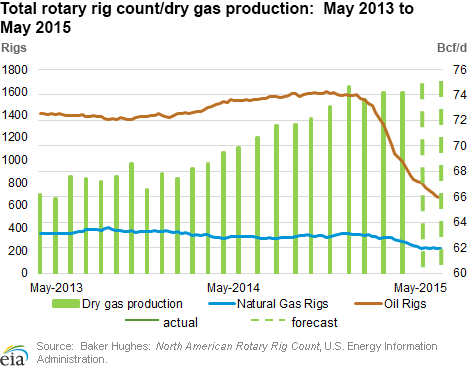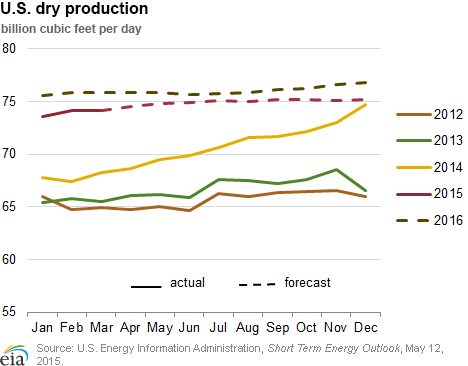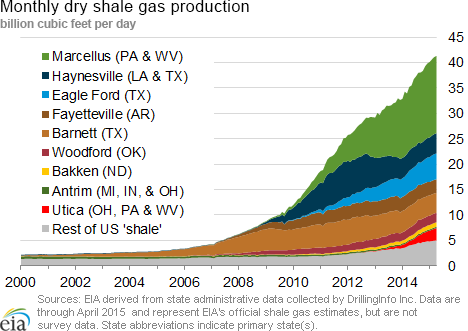In the News:
Rig count is down, but 2015 gas production forecast to grow over 2014 levels
The number of rigs in operation, as of May 8, totaled 894, a drop of more than 1,000 since 2014's September 26 peak of 1,930 rigs, according to data from Baker Hughes. Of these, 668 rigs were targeting oil and 221 were targeting gas. As recently as November 2011, there were as many gas rigs active as there are total rigs today, and in August 2008, when shale gas exploration was ramping up, there were 1,606 gas rigs, representing 79% of all rigs deployed nationwide.
Over the past several years, the rig count has fallen, but without reducing production. This has been accomplished largely because of gains in rig efficiency, including improved technology but also the higher quality of the rigs and crews that are still operating (when companies cut back, they start with the least-efficient rigs). In addition, companies are making decisions to focus on their best production opportunities, a tactic called high-grading. More recently, a 49% drop in crude oil prices from June 2014 to April 2015, and a 43% drop in natural gas prices in the same period, has led operators to reduce the number of rigs in use, with a decrease in oil rigs accounting for 90% of the total rig decline. While oil and gas prices have been generally increasing since mid-March and mid-April of 2015, respectively, making up for a portion of earlier declines, they still remain relatively low compared to recent history.
Even with the decline in rigs, U.S. dry natural gas production continued to grow, reaching record highs in December 2014 of more than 74.3 billion cubic feet per day (Bcf/d), and retaining an average production in February 2015 of more than 74.2 Bcf/d, a 10% year-over-year rise from February 2014. EIA projects that dry natural gas production will increase year-over-year by 4.3 Bcf/d (6.0%) in 2015, reflecting continuing production growth in the Lower 48 states. In particular, EIA's Short-Term Energy Outlook expects that most of the growth will come from the Marcellus Shale, as a backlog of drilled wells are completed and new pipelines come online to deliver Marcellus gas to a broader market. Additionally, even with the reduction of active natural gas-targeted rigs, there is a backlog of drilled but uncompleted wells that are positioned to support production, especially as prices recover.
Overview:
(For the Week Ending Wednesday, May 13, 2015)
- Prices of natural gas at most trading locations increased over the report week (Wednesday, May 6 – Wednesday, May 13), but they still remained at relatively low levels. Henry Hub spot prices began the week at $2.75 per million British thermal units (MMBtu) last Wednesday and ended the week at $2.86/MMBtu yesterday.
- At the New York Mercantile Exchange, the near-month contract (June 2015) rose from $2.776/MMBtu last Wednesday to $2.935/MMBtu yesterday.
- Working natural gas in storage increased to 1,897 Bcf as of Friday, May 8, according to the U.S. Energy Information Administration (EIA) Weekly Natural Gas Storage Report (WNGSR). A net injection into storage of 111 Bcf for the week resulted in storage levels 65.7% above year-ago levels and 2.0% below the five-year average for this week.
- The total rig count for May 8 fell by 11 units from the previous week to 894, according to data reported by Baker Hughes Inc. Oil rigs fell by 11 units to 668, while natural gas rigs declined by 1 unit to 221. One miscellaneous rig was added during the week.
- The natural gas plant liquids composite price fell by 18¢ to $5.52/MMBtu for the week ending May 8. With the exception of the ethane price, which rose by 3.4%, all of the other Mont Belvieu natural gas liquid prices fell this week. Natural gasoline, propane, butane, and isobutane prices fell by 0.4%, 7.2%, 4.6%, and 3.9%, respectively.
Prices/Demand/Supply:
Outside of the Northeast, prices rise. Prices at the Henry Hub rose from $2.75/MMBtu last Wednesday to $2.86/MMBtu yesterday, posting a net increase for the second week in a row. Prices at many other trading locations moved in a similar pattern. At the Chicago Citygate, prices increased from $2.74/MMBtu last Wednesday to $2.87/MMBtu yesterday. At the PG&E Citygate inNorthern California, prices rose from $3.13/MMBtu last Wednesday to $3.20/MMBtu yesterday.
Temperatures are at different extremes. East of the Rockies, temperatures were warmer than normal during the report week. On Sunday and Monday, high temperatures reached into the 80s across most of the eastern half of the country, with temperatures exceeding 90° Fahrenheit in areas of Texas and Florida. However, at the same time, a snowstorm covered the Denver area with nearly a foot of snow. Despite the differences in weather, outside the Northeast, price movements were similar over the report week across the country. The Opal spot price rose 13¢ from $2.52/MMBtu last Wednesday to $2.65/MMBtu yesterday, mirroring price movements around the country.
Northeast price movements are mixed. At the Algonquin Citygate, servicing Boston, prices fell from $2.06/MMBtu last Wednesday to $1.91/MMBtu yesterday, after reaching $2.62/MMBtu on Monday, likely because of higher levels of natural gas consumed in the electric power sector (power burn). Prices at Transcontinental Pipeline's Zone 6 trading point for delivery into New York City rose from $2.80/MMBtu last Wednesday to $2.86/MMBtu yesterday, after peaking at $3.03 on Monday — the first time these prices were greater than $3.00/MMBtu since early March.
Marcellus prices move lower. Marcellus-area price movements were both up and down, but prices still remained very low overall. At Tennessee's Zone 4 Marcellus trading location, prices posted an overall 1¢ increase from $1.31/MMBtu to $1.32/MMBtu yesterday, but they had reached $1.59/MMBtu earlier in the week. On the Transco Leidy Line, prices fell from $1.49/MMBtu to $1.43/MMBtu. At Dominion South, which serves customers in portions of Pennsylvania, Ohio, Maryland, West Virginia, and Virginia, prices fell from $1.73/MMBtu to $1.52/MMBtu.
Nymex prices rise. At the Nymex, the June 2015 contract rose from $2.776/MMBtu last Wednesday to $2.935/MMBtu yesterday. The price of the 12-month strip (the 12 contracts from June 2015 to May 2016) also rose, increasing from $3.029/MMBtu last Wednesday to $3.148/MMBtu yesterday.
Total supply increases. Total supply rose slightly this week, according to data from Bentek Energy. Dry production moved up slightly, rising 0.1% from the previous week, but it was 6.8% greater than the same period a year ago. Imports of natural gas from Canada to the United States rose 6.3%, with increases occurring in the West and Midwest. LNG sendout remained minimal.
Power burn drives consumption increase. Total consumption of natural gas rose 5.1% from last week, with the largest increases occurring in the power sector, where consumption rose 13.8%, as many areas experienced the first taste of summer weather this week. The largest increases in power consumption this week were in the Southeast—which is also the largest overall power-consuming sector—where power burn rose 25.1% week over week and averaged 9.6 Bcf/d. The Northeast also posted a similarly large increase in power burn this week, increasing 19.9% to an average of 6.3 Bcf/d. Residential and commercial consumption increased 0.8%, and industrial consumption fell 1.5% from the previous week.
Storage
Net storage injection is larger than the five-year average and last year's builds for this week. The net injection reported for the week ending May 8 was 111 Bcf, up from 76 Bcf the previous week. This level compares with the five-year average net increase of 82 Bcf for that week and last year's net increase of 101 Bcf. Working gas inventories for the storage week totaled 1,897 Bcf, 752 Bcf (65.7%) higher than last year at this time and 38 Bcf (2.0%) lower than the five-year (2010-14) average.
Storage injections are lower than market expectations. Market expectations, on average, called for a build of 117 Bcf. When the EIA storage report was released at 10:30 a.m. on May 14, the price for the June natural gas futures contract increased 6¢ to $2.95/MMBtu in trading on the Nymex, and increased another 6¢ to $3.01 a few minutes later.
From the week ending April 3 (the beginning of the injection season) through the week ending May 8, net storage injections totaled 436 Bcf, or 40% more than the 312 Bcf injected during the same five weeks in 2014. During these weeks between 2010 and 2014, on average, net injection into storage totaled 284 Bcf. The estimated average unit value of the natural gas storage holders put into storage from April 3 to May 8 this year was $2.64/MMBtu, 44% lower than the average value of $4.71/MMBtu for the same six weeks last year. The highest winter-month Nymex price (for the January 2016 contract) in trading for the week ending May 8 averaged $3.29/MMBtu. This price is 50¢/MMBtu more than the June Nymex contract price. A year ago, the difference was 17¢/MMBtu, suggesting there is more financial incentive this year to buy and store natural gas in the summer for sale in the winter.
There are currently 25 more weeks in the injection season, which traditionally runs from April 1 through October 31, although in many years injections continue into November. EIA forecasts that the end-of-October working natural gas inventory level will be 3,890 Bcf, which, as of May 8, would require an average injection of 80 Bcf per week through the end of October. EIA's forecast for the end-of-October inventory level is above the five-year (2010-14) average peak storage value of 3,813 Bcf. To reach the five-year average peak value, average weekly injections through the end of October would need to be 77 Bcf.
All three regions report net injections for the week. Net injections for the week in the East were 59 Bcf (11 Bcf larger than its five-year average injection). They were 8 Bcf (3 Bcf smaller than its five-year average) in the West and 44 Bcf (22 Bcf larger than its five-year average) in the Producing region. The East region's inventory is below its five-year average by 150 Bcf (17.9%). In contrast, stock levels in the West and Producing regions are above their five-year averages for the week, by 68 Bcf (22.1%) and 45 Bcf (5.7%), respectively. Storage levels for the East, West, and Producing regions are above their year-ago levels by 239 Bcf, 159 Bcf, and 354 Bcf, respectively.
Temperatures during the storage report week are warmer than normal. Temperatures in the Lower 48 states averaged 63° for the storage report week, 4.1° warmer than the 30-year normal temperature and 3.3° warmer than the average temperature during the same week last year. There were 31 population-weighted heating degree days (HDD) during the storage report week, 12 HDD fewer than the five-year average and 23 HDD fewer than during the same period last year. There were also 17 population-weighted cooling degree days (CDD) this report week, 1 CDD less than the five-year average and the same as during this week last year.
See also:
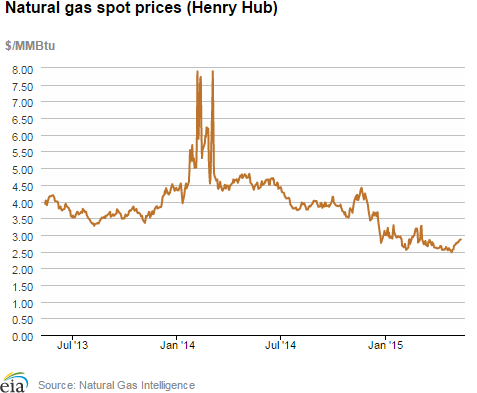
| Spot Prices ($/MMBtu) | Thu, 07-May |
Fri, 08-May |
Mon, 11-May |
Tue, 12-May |
Wed, 13-May |
|---|---|---|---|---|---|
| Henry Hub |
2.78 |
2.77 |
2.85 |
2.86 |
2.86 |
| New York |
2.77 |
2.83 |
3.03 |
2.91 |
2.86 |
| Chicago |
2.75 |
2.77 |
2.87 |
2.92 |
2.87 |
| Cal. Comp. Avg,* |
2.82 |
2.85 |
2.90 |
2.92 |
2.89 |
| Futures ($/MMBtu) | |||||
| June contract |
2.734 |
2.880 |
2.802 |
2.897 |
2.935 |
| July contract |
2.785 |
2.928 |
2.849 |
2.945 |
2.984 |
| *Avg. of NGI's reported prices for: Malin, PG&E citygate, and Southern California Border Avg. | |||||
| Source: NGI's Daily Gas Price Index | |||||
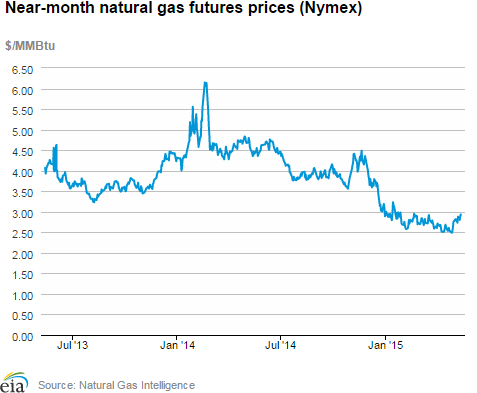
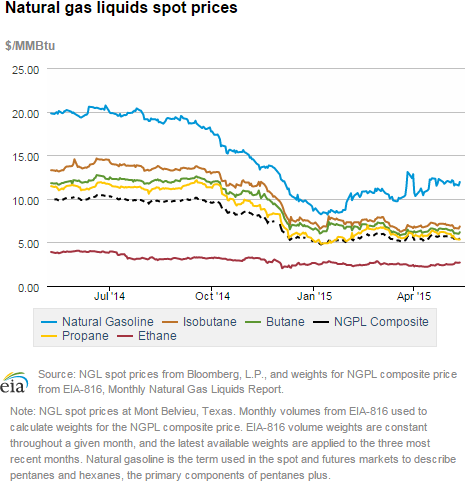
| U.S. natural gas supply - Gas Week: (4/29/15 - 5/6/15) | ||
|---|---|---|
Percent change for week compared with: |
||
last year |
last week |
|
| Gross production | 6.85%
|
0.07%
|
| Dry production | 6.79%
|
0.07%
|
| Canadian imports | 2.64%
|
6.26%
|
| West (net) | 22.23%
|
2.50%
|
| Midwest (net) | -13.86%
|
5.20%
|
| Northeast (net) | 58.10%
|
-43.37%
|
| LNG imports | -68.22%
|
-0.91%
|
| Total supply | 6.41%
|
0.46%
|
| Source: BENTEK Energy LLC | ||
| U.S. consumption - Gas Week: (5/6/15 - 5/13/15) | ||
|---|---|---|
Percent change for week compared with: |
||
last year |
last week |
|
| U.S. consumption | 6.4%
|
5.1%
|
| Power | 16.0%
|
13.8%
|
| Industrial | -1.0%
|
-1.5%
|
| Residential/commercial | 1.9%
|
0.8%
|
| Total demand | 7.8%
|
5.1%
|
| Source: BENTEK Energy LLC | ||
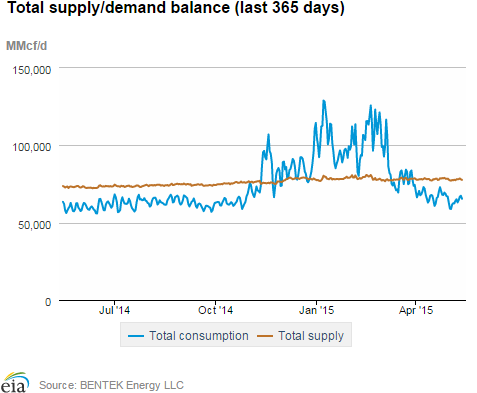
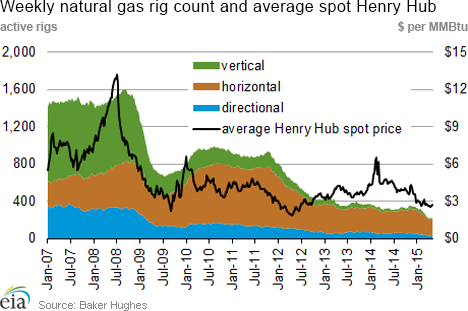
| Rigs | |||
|---|---|---|---|
Fri, May 08, 2015 |
Change from |
||
last week |
last year |
||
| Oil rigs | 668 |
-1.62% |
-56.28% |
| Natural gas rigs | 221 |
-0.45% |
-31.58% |
| Miscellaneous | 5 |
25.00% |
25.00% |
| Rig numbers by type | |||
|---|---|---|---|
Fri, May 08, 2015 |
Change from |
||
last week |
last year |
||
| Vertical | 114 |
0.88% |
-71.78% |
| Horizontal | 692 |
-1.00% |
-44.33% |
| Directional | 88 |
-5.38% |
-57.69% |
| Source: Baker Hughes Inc. | |||
| Working gas in underground storage | ||||
|---|---|---|---|---|
Stocks billion cubic feet (bcf) |
||||
| Region | 2015-05-08 |
2015-05-01 |
change |
|
| East | 687 |
628 |
59 |
|
| West | 376 |
368 |
8 |
|
| Producing | 834 |
790 |
44 |
|
| Total | 1,897 |
1,786 |
111 |
|
| Source: U.S. Energy Information Administration | ||||
| Working gas in underground storage | |||||
|---|---|---|---|---|---|
Historical comparisons |
|||||
Year ago (5/8/14) |
5-year average (2010-2014) |
||||
| Region | Stocks (Bcf) |
% change |
Stocks (Bcf) |
% change |
|
| East | 448 |
53.3 |
837 |
-17.9 |
|
| West | 217 |
73.3 |
308 |
22.1 |
|
| Producing | 480 |
73.8 |
789 |
5.7 |
|
| Total | 1,145 |
65.7 |
1,935 |
-2.0 |
|
| Source: U.S. Energy Information Administration | |||||
| Temperature -- heating & cooling degree days (week ending May 07) | ||||||||
|---|---|---|---|---|---|---|---|---|
HDD deviation from: |
CDD deviation from: |
|||||||
| Region | HDD Current |
normal |
last year |
CDD Current |
normal |
last year |
||
| New England | 51
|
-37
|
-28
|
0
|
0
|
0
|
||
| Middle Atlantic | 31
|
-42
|
-37
|
2
|
1
|
2
|
||
| E N Central | 34
|
-43
|
-53
|
8
|
5
|
7
|
||
| W N Central | 29
|
-38
|
-44
|
16
|
10
|
6
|
||
| South Atlantic | 20
|
-11
|
-5
|
31
|
5
|
-5
|
||
| E S Central | 21
|
-7
|
-6
|
26
|
9
|
3
|
||
| W S Central | 6
|
-2
|
-9
|
45
|
5
|
3
|
||
| Mountain | 52
|
-28
|
-5
|
17
|
4
|
-1
|
||
| Pacific | 38
|
-10
|
8
|
5
|
-1
|
-10
|
||
| United States | 31
|
-26
|
-23
|
17
|
3
|
0
|
||
|
Note: HDD = heating degree-day; CDD = cooling degree-day Source: National Oceanic and Atmospheric Administration | ||||||||
Average temperature (°F)
7-Day Mean ending May 07, 2015
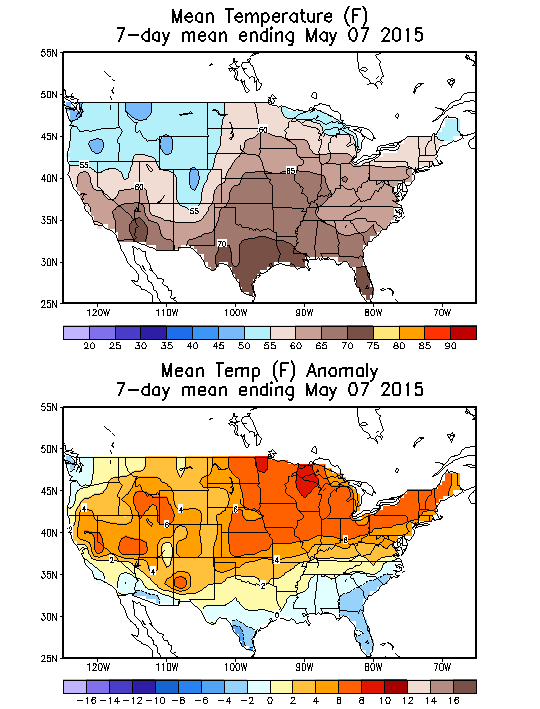
Source: NOAA/National Weather Service
Deviation between average and normal (°F)
7-Day Mean ending May 07, 2015

Source: NOAA/National Weather Service

